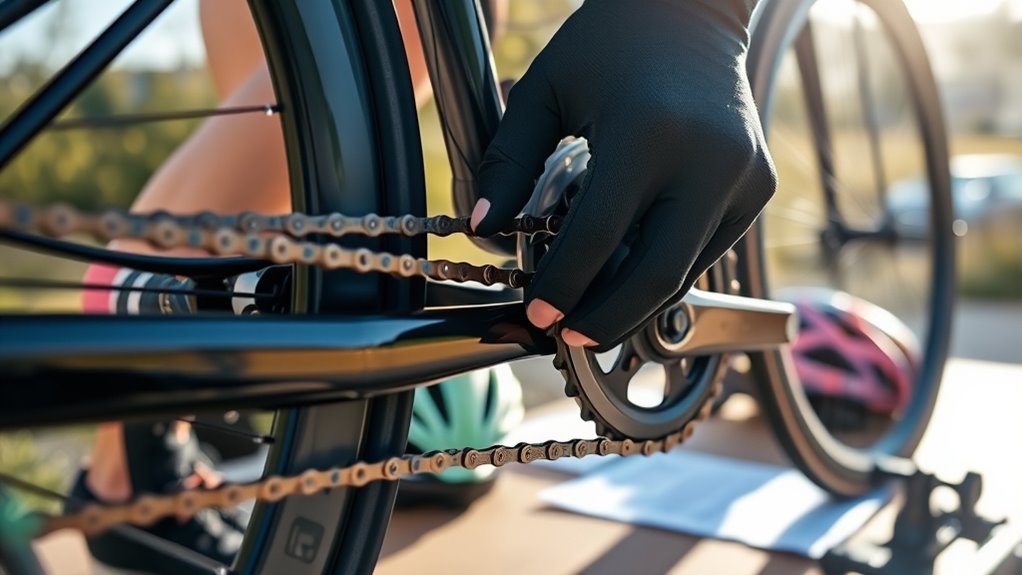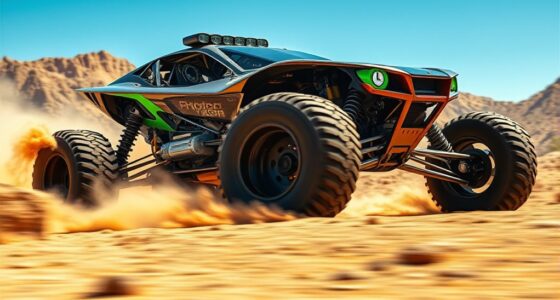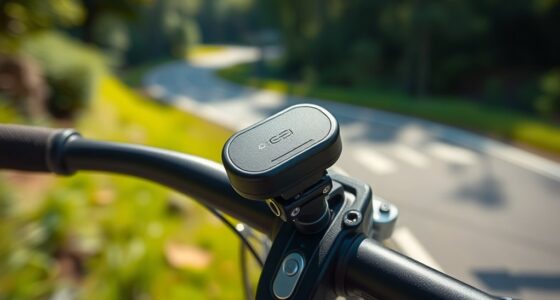Before each ride, you should check your tires for proper pressure and tread depth, ensuring they’re inflated correctly and free of damage. Test your brakes and confirm they respond well, with fluid levels topped off. Verify all lights and signals work properly for safety visibility. Tighten fasteners on handlebars, wheels, and critical parts. Finally, test your ride controls and safety features. If you want to know more details, keep going for a complete, effective inspection routine.
Key Takeaways
- Regularly check tire pressure, tread depth, and proper inflation to ensure optimal grip and prevent blowouts at high speeds.
- Inspect drive components like chains, belts, and shafts for cracks, proper tension, and lubrication to avoid mechanical failures.
- Verify brake system functionality, including pad wear, fluid levels, and responsiveness, for reliable stopping power.
- Ensure all fasteners, bolts, and critical components are securely tightened to manufacturer specifications using torque tools.
- Test lighting, signals, and safety features to confirm visibility and communication, reducing speed-related accidents.
Checking Tire Pressure and Tread Depth
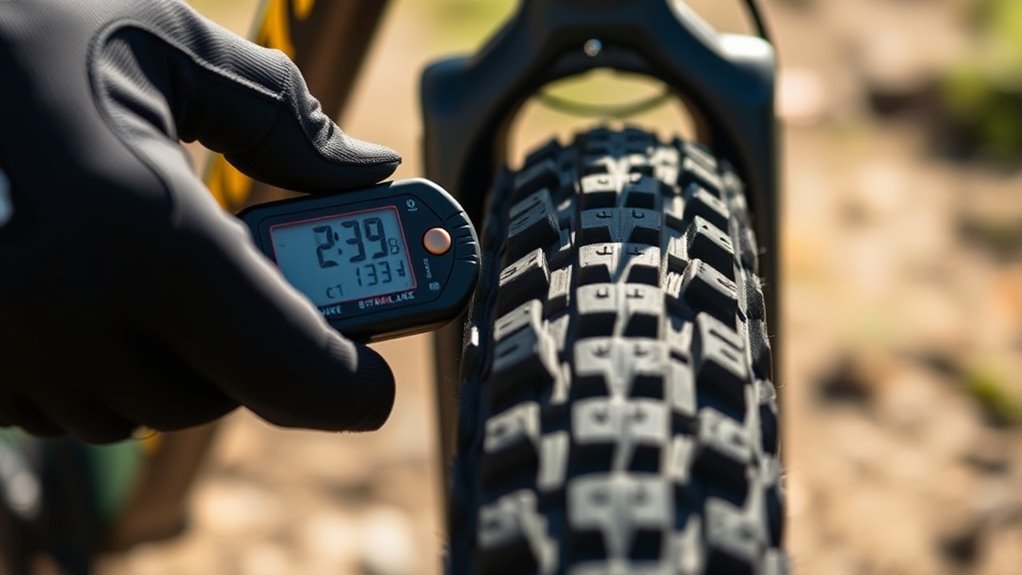
Before hitting the road, it’s essential to check your tire pressure and tread depth. Proper tire pressure ensures your vehicle handles correctly, improves fuel efficiency, and reduces the risk of blowouts. Use a reliable tire pressure gauge to measure each tire’s pressure, and compare it to the manufacturer’s recommended psi, usually found in your owner’s manual or on a sticker inside the driver’s door. Underinflated tires can cause poor traction and uneven wear, while overinflated tires might lead to a rough ride and reduced grip. Additionally, inspect your tread depth to ensure your tires can handle wet or slippery surfaces. Use a tread depth gauge or a simple penny test—if you can see the top of Lincoln’s head, it’s time for new tires. Keeping tires properly inflated and treaded keeps you safer on every ride, and staying mindful of cultural impact can help you understand how your vehicle’s maintenance fits into broader societal trends.
Inspecting Brake Functionality and Fluid Levels
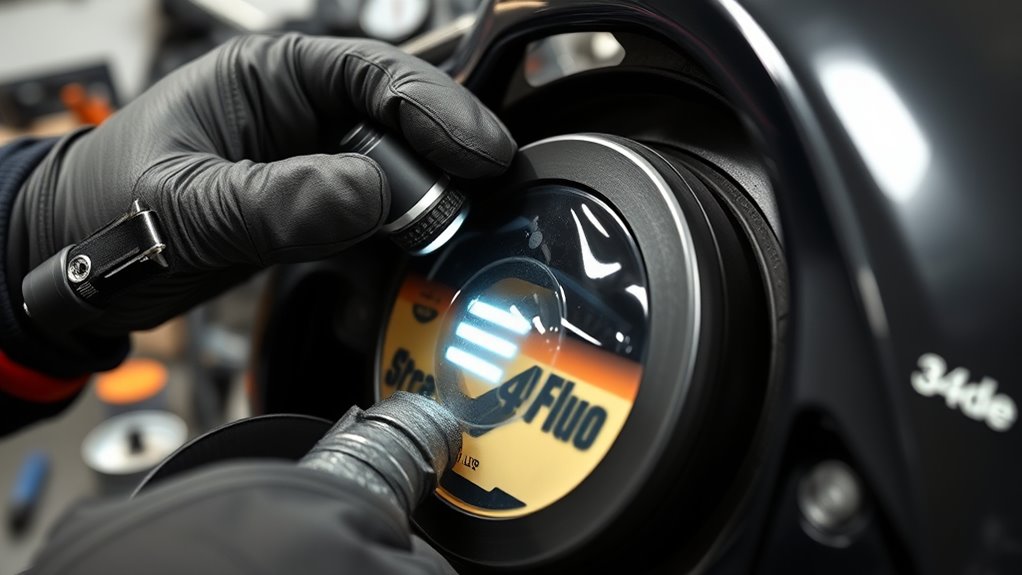
Start by squeezing the brake lever to guarantee it feels firm and responds quickly. Check the brake fluid levels and top off if needed, making sure they’re within the recommended range. Finally, inspect the brake pads for wear and tear to confirm they’ll provide reliable stopping power.
Brake Lever Response
To guarantee your brakes respond quickly and reliably, you should first check the brake lever’s response. Squeeze the lever firmly and observe how it reacts. It should feel firm and engage immediately without excessive travel or sponginess. If the lever feels soft or sinks too far toward the handlebar, it indicates potential issues with the brake system, such as air in the lines or worn components. Ensure the lever returns smoothly to its resting position after each squeeze. Any delay, unusual stiffness, or inconsistent response can compromise braking performance. Make adjustments if necessary, such as tightening the cable or replacing worn parts. A responsive brake lever is essential for quick stopping and safe riding, especially when encountering sudden obstacles or emergencies.
Fluid Level Checks
Checking the brake fluid levels is essential to make certain your braking system functions properly. You should regularly inspect the fluid reservoir, which is usually located near the handlebars. Ensure the fluid level stays between the minimum and maximum marks. Low fluid can cause brake failure or reduced responsiveness, so top it off with the recommended type if necessary. Use a clean cloth to wipe away any dirt around the reservoir cap before opening it. Avoid overfilling, as excess fluid can lead to leaks or damage. Also, check for any discoloration or debris in the fluid—dark or contaminated fluid indicates it needs replacement. Maintaining proper fluid levels helps guarantee your brakes respond reliably, giving you peace of mind during your ride. Regularly checking your shower fixtures can prevent leaks and ensure optimal performance.
Brake Pad Condition
Inspecting your brake pads is crucial to guarantee your braking system works effectively and safely. Worn or damaged pads reduce stopping power and increase the risk of failure. To assess their condition:
- Check the thickness—replace if less than 3mm.
- Look for uneven wear or cracks on the pad surface.
- Listen for squealing noises during braking.
- Examine for any signs of contamination or debris.
- Consider AI-driven diagnostics that can analyze brake performance for early issue detection.
Ensure brake fluid levels are adequate, as low fluid can impair braking performance. Also, test the brake pedal for firmness; a spongy pedal indicates potential issues. Regularly inspecting these components keeps your brakes responsive and reliable, preventing speed-related failures. Remember, a proactive approach to brake maintenance enhances safety and ensures a smooth ride every time.
Ensuring Proper Lighting and Signal Operation
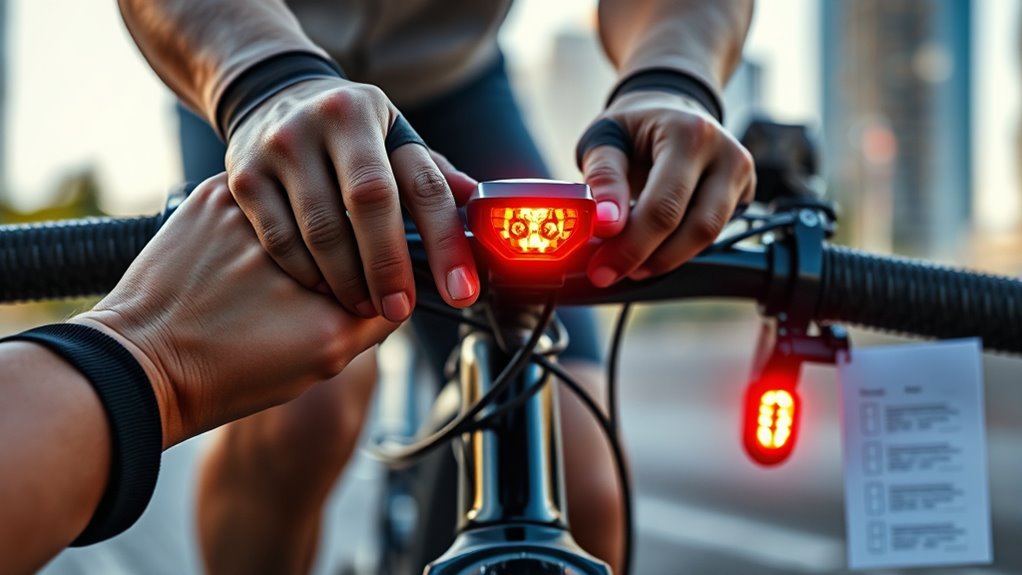
Ensuring your lights and signals work properly is essential for safe riding. Before every ride, check that your headlights, taillights, and brake lights are functioning correctly. Turn on your headlights to verify they illuminate clearly and evenly. Test your turn signals by activating each side to confirm they flash properly and the indicators on your dashboard respond. Don’t forget to check your brake lights—press the brake lever or pedal and observe if the lights brighten or activate. Proper lighting guarantees you’re visible to other drivers, especially in low-light conditions or at night. Signal intentions clearly to prevent misunderstandings and accidents. Regularly inspecting and maintaining your lighting system keeps you safe and compliant with traffic laws, reducing the risk of speed-related failures caused by poor visibility. Additionally, understanding AI applications in learning can help you stay informed about emerging safety technologies that enhance rider visibility and communication.
Verifying Chain, Belt, or Drive Shaft Condition
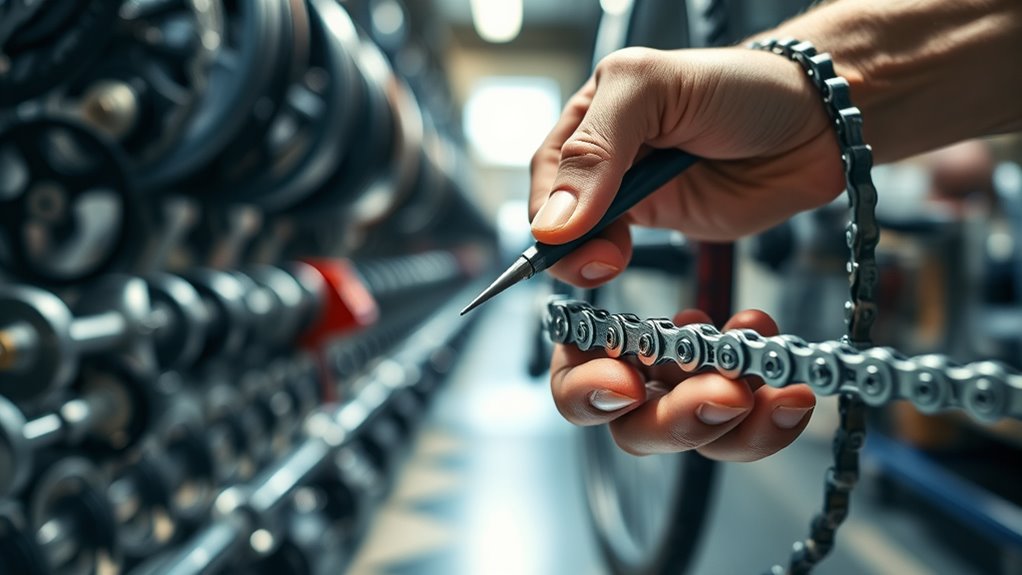
A well-functioning drive system is vital to smooth and safe riding. Before hitting the road, check your chain, belt, or drive shaft for any issues. First, inspect for visible damage like cracks, wear, or corrosion. Second, ensure the chain or belt is properly tensioned—neither too tight nor too loose. Third, look for lubrication spots; a dry or rusty drive indicates neglect. Fourth, verify that the drive shaft moves freely without wobbling or unusual noise. Address any signs of damage or slack immediately. Regular inspection prevents sudden failures that can cause speed-related problems. Checking the drive system regularly ensures optimal performance and longevity. Remember, a reliable drive system keeps your ride smooth and safe, so don’t skip this essential step in your pre-ride routine.
Examining Fluid Levels and Leakages
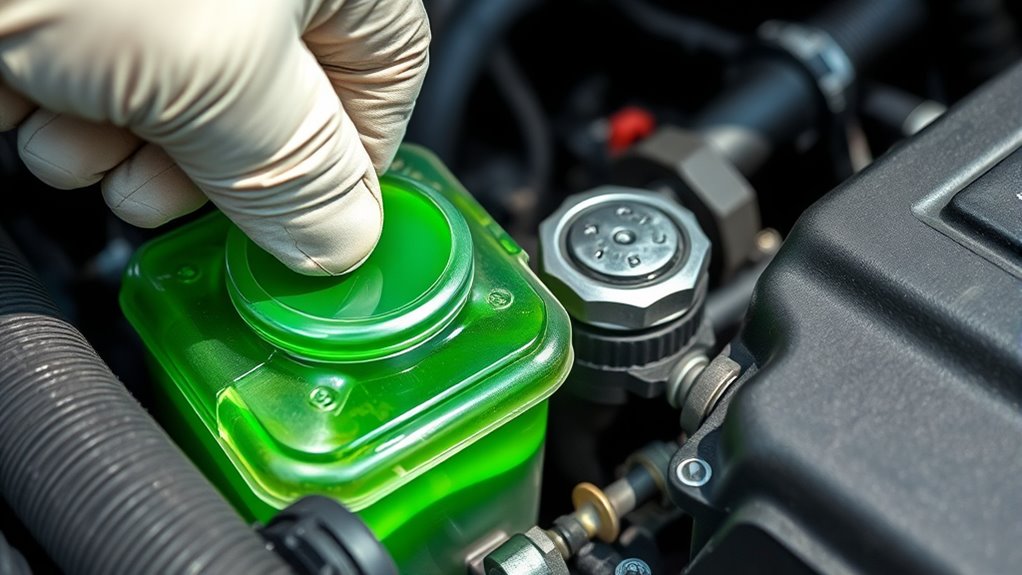
To keep your vehicle running smoothly, you need to check fluid levels and look for leaks before each ride. Start by inspecting the engine oil, transmission fluid, brake fluid, coolant, and power steering fluid, ensuring they’re at the recommended levels. Low fluids can cause overheating, poor performance, or component failure. Wipe dipsticks clean before checking and top off fluids if necessary, using the correct type. Next, examine the engine and undercarriage for any signs of leaks—wet spots, stains, or puddles. Leaks can indicate frayed hoses, damaged seals, or cracked components, which could lead to serious failures if ignored. Address leaks promptly to prevent fluid loss and maintain ideal vehicle safety and performance during your ride. Regularly inspecting filtration systems can also help prevent allergens and dust buildup that may impair engine performance.
Confirming Secure Fastenings and Bolts

Before you hit the road, guarantee all fastenings and bolts are secure. Regularly check their tightness using the proper tools to prevent any loosening during your ride. Pay special attention to critical components to keep your bike safe and reliable. Being aware of potential small mistakes can help you avoid overlooked issues that might cause failures.
Check Tightness Regularly
Regularly checking the tightness of fastenings and bolts guarantees your bike stays safe and reliable during each ride. Loose components can lead to accidents or mechanical failure, especially at high speeds. To ensure everything stays secure, focus on these key areas:
- Inspect critical bolts on the handlebars, stem, and seat post.
- Check wheel axles and quick-release levers for proper tightness.
- Verify crank bolts and chainring bolts are snug.
- Ensure brake calipers and levers are firmly attached.
- Remember that using vintage decor elements like antique fixtures can sometimes require extra attention to fastenings, as older hardware may loosen over time.
Make it a routine before every ride to catch any looseness early. Use your fingers and a torque wrench if available, but always don’t overtighten. Staying attentive to fastener tightness keeps your bike safe and prevents speed-related failures.
Use Proper Tools
Using the right tools is crucial for guaranteeing all fastenings and bolts are properly secured. Using the correct size and type of wrench or socket ensures you don’t strip or damage fasteners. Avoid improvising with tools that don’t fit, as this can lead to loose or compromised connections. Always double-check that your tools are in good condition—worn or damaged tools can cause improper tightening. Confirm that each bolt and fastener is tightened to the manufacturer’s specifications, using a torque wrench if necessary. Proper tools help you apply the right amount of force, preventing over-tightening or under-tightening. This not only guarantees safety but also prolongs the lifespan of components. Making sure you have the right tools is a simple but crucial step in your pre-ride inspection routine. Ensuring proper torque application is especially important to prevent failures caused by incorrect tightening.
Inspect Critical Components
Inspecting critical components involves carefully checking that all fastenings and bolts are secure. Loose or missing bolts can lead to component failure, risking safety during your ride. To do this effectively:
- Visually inspect each bolt and fastener for tightness and signs of wear.
- Use a torque wrench to verify bolts are tightened to manufacturer specifications.
- Check for corrosion or rust that could weaken fastenings.
- Ensure locking mechanisms, like cotter pins or lock nuts, are properly in place.
Testing Ride Controls and Safety Features

Before hitting the road, it’s vital to test your ride controls and safety features to guarantee everything functions correctly. Begin by checking the brakes—squeeze the brake levers or pedals firmly to ensure they respond smoothly and stop efficiently. Test the throttle or acceleration controls to confirm they move freely and return to idle without sticking. Verify that your clutch and gear shifters engage smoothly, shifting through all gears without resistance. Don’t forget to activate any safety features, such as emergency stop buttons, warning lights, or alarms, to confirm they operate correctly. Make sure your mirrors are properly adjusted for visibility. Additionally, understanding AI’s role in enhancing safety features can help you recognize advanced functionalities integrated into modern vehicles. By thoroughly testing these controls and features, you reduce the risk of mechanical failures or safety hazards during your ride.
Frequently Asked Questions
How Often Should I Perform a Pre-Ride Inspection?
You should perform a pre-ride inspection every time before you ride. This routine helps you catch any issues that could cause problems or failures, especially when riding at high speeds. Make it a habit to check tire pressure, brakes, lights, and fluid levels. Regular inspections ensure your bike is safe, reliable, and ready to perform, giving you peace of mind and helping prevent accidents caused by speed-related failures.
What Tools Are Recommended for a Thorough Check?
Imagine you’re a detective gathering clues before a big case. You’ll need a few key tools: a tire pressure gauge to keep your wheels rolling smoothly, a flashlight to spot hidden issues, and a wrench for quick adjustments. A mirror helps check hard-to-see spots, while a clean cloth guarantees nothing slips through. With these tools, you’re well-equipped to catch problems early and ensure a safe, speedy ride.
How Can I Identify Early Signs of Component Wear?
To spot early signs of component wear, you should regularly inspect crucial parts like brakes, tires, and belts for cracks, fraying, or unusual vibrations. Pay attention to any changes in how your vehicle responds, such as squealing brakes or reduced handling. Keep an eye on fluid leaks and listen for strange noises. Consistent visual checks and attentive observation help catch wear early, preventing potential failures and ensuring safe, smooth rides.
Are There Specific Safety Checks for Different Vehicle Types?
You often find yourself wondering if safety checks vary by vehicle type, and it’s no coincidence. Different vehicles demand tailored inspections—motorcycles need tire pressure and brake checks, while cars require fluid levels and belt inspections. By understanding these specifics, you guarantee safety and reliability. Regularly performing these targeted checks, you catch issues early, preventing failures and giving you peace of mind on every ride.
What Should I Do if I Find a Potential Issue During Inspection?
If you find a potential issue during inspection, you should stop and assess the problem immediately. Don’t ignore or try to fix it yourself unless you’re trained. Notify the appropriate personnel or supervisor and follow your safety protocols. Make sure the vehicle is safe before proceeding. Addressing issues promptly prevents accidents, keeps you safe, and ensures the vehicle operates correctly, avoiding future failures or hazards.
Conclusion
By performing this pre-ride inspection, you’re forging a shield of reliability around your ride, like a vigilant guardian standing watch. Each check acts as a crucial stitch in the fabric of safety, weaving confidence into every mile. When your bike is finely tuned and thoroughly examined, you’re not just riding—you’re orchestrating a symphony of control and assurance. Embrace this routine, and let your journey flow as smoothly as a well-conducted melody.
